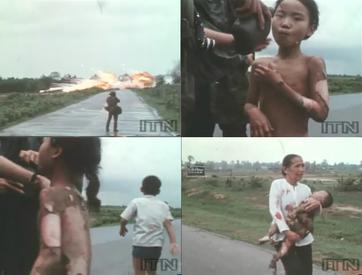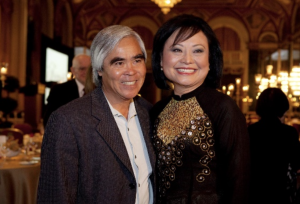“Napalm Girl – Never Stop Running Napalm Girl”: A Story of Atrocities in the Vietnam War. Peter Koenig

All Global Research articles can be read in 51 languages by activating the Translate Website button below the author’s name (only available in desktop version).
To receive Global Research’s Daily Newsletter (selected articles), click here.
Click the share button above to email/forward this article to your friends and colleagues. Follow us on Instagram and Twitter and subscribe to our Telegram Channel. Feel free to repost and share widely Global Research articles.
Global Research Wants to Hear From You!
***
My generation is old enough to still remember the Vietnam War – another American invasion, another US killing atrocity by psychopaths leading governments, another bonanza for the war industry.
This is now 50-plus years back, and the empire’s strategies to dominate the world, subdue its people, has not changed.
In the meantime, dozens of wars and conflicts have been initiated and fought either by the United States or its proxies, killing and maiming tens of millions of people around the world; as the world is sinking deeper and deeper into a dark abyss, from which one day, there may be no return.
But maybe there is hope.
What inspired me to write about Kim Phùc’s story – the “Never Stop Running, Napalm Girl” – is the short affectionate, yet strong and expressive anti-war video clip by Ray Jason, released in April 2024. Ray also provided the title for this article. See video below.
Vietnam – The 20-year War (1955 – 1975)
You may remember the famous picture of the nine-year-old Phan Thi Kim Phùc, or Kim for short, who keeps running naked for her life from a US napalm attack that has scorched the cloths off her body, screaming in fear – never stopping from running. Kim was born on April 6, 1963.
Image: “The Terror of War”, photograph showing Phan Thi Kim Phuc running down a road near Trảng Bàng, Vietnam, after a napalm bomb was dropped on the village of Trảng Bàng by a plane of the Vietnam Air Force. (Licensed under PD-US)

On 8 June 1972 at Tràng Bàng, during the 20-year Vietnam War (1955-1975), Nick Ut took the iconic “Napalm Girl” photo (above). The then 21-year-old Associated Press (AP) photographer won the 1973 Pulitzer Prize for his famous photo, titled, “The Terror of War”.
The picture was also chosen as the Word Press Photo of the Year for 1973.
Rightly or wrongly, the photograph has often been credited with initiating the Vietnam Peace process, by showing the people of the world innocent victims’ faces.
Nick, the photographer, saved Kim’s life by taking her as an emergency to a Saigon hospital. They first did not want to admit her, saying that with her burns she would never survive. But Nick insisted, threatening them with going to the media, if they would refuse to help her, doing their best to save her life. They did, and saved Kim.
In an interview some 20 years ago, Nick Ut, a veteran, retired from AP, and now Vietnamese-Canadian citizen, exuberated:
“That terrified little girl is still alive today and has become an eloquent testimony to the authenticity of that photo. That moment thirty years ago will be one Kim Phúc and I will never forget. It has ultimately changed both our lives.”
Kim and Nick Ut have remained friends and posed for pictures at the 40th Anniversary Tribute Dinner in Honor of Kim Phuc in Toronto, June 8, 2012. (Photo left by Matthew Sherwood/Reuters)
Today, Kim lives near Toronto with her family and helps other children-victims of war around the world. In between her trips, she shares her story with The World.
Kim Phúc founded the Kim Foundation International to provide aid to child victims of war. See this.
In a February 2018 interview with The World, Kim Phúc described that day of horror, June 8, 1972:
“We were allowed to play inside of the temple nearby the bomb shelter. I remember after lunch, we heard the noise of some burning outside … suddenly, the soldiers asked the children to run out of the temple.”
“I saw the planes were very fast, very loud. As a child, I didn’t know anything. And I turned my head. I saw four bombs landing … then suddenly, the fire was everywhere around me. I didn’t see anybody else. And then the fire burned off my clothes, and I saw the fire on my left arm. I used my right hand to wrap it up. That’s why my right hand got burned, as well.”
The World: You just put the fire out with your hand?
“Yes. That moment, I was terrified, you know. Then, I ran out of that fire, and I saw my brothers and my cousins and some soldiers with us, probably South Vietnamese soldiers, who protected us in the temple. Then, we kept running and running and running, until I was too tired to run anymore. And I saw a lot of people. They stood on the street, and I cried out, “Too hot, too hot.” And I remember one of the soldiers; he gave me some water to drink. He poured water over my skin. At that moment, I passed out. I didn’t remember anything. I lost consciousness that day.”
The World: After you lost consciousness, do you remember the following week? What happened afterward?
“Oh, for a long time, I had no idea when my memory came back.”
“After I got burned, I had a dream. I really wanted to become a doctor. Then, I got into medical school but then, at that moment, the Vietnamese government rediscovered me. I was that little girl in a famous picture, right? So, many foreign journalists came to Vietnam, and they wanted to interview me. So, because of that reason, I was put out of my school to basically do publicity [for the government].”
“And that was really a low point in my life. I didn’t have any freedom to do whatever I wanted.”
“Later, the Vietnamese government sent me to Cuba to study for six years. Then, I married a Vietnamese student, whom I met in my university. On the way back to Cuba [from our honeymoon to Moscow], our airplane had to stop in in Gander, Newfoundland, Canada, for refueling. So, for one hour in that location, I took my chance; my husband and I defected [asking for Canadian political asylum, which they were granted]. Then our life was set up in Toronto. We had freedom in Canada.”
Now, Kim is married (1992) to Bui Huy Toan. The couple has two children and lives in Ajax, Ontario, with their two children. In 1997, they became Canadian citizens.
The World: You have such an optimistic view of how things can proceed in life after you went through so much. Are you ever angry?
“Right now, no. But before, yes. Before I held the hatred for a while. And I learned to forgive. I learned to love my enemies. That is from learning. I’m not born with that. I was raised in a different religion. I was raised in a Cao Dai religion in Vietnam, but I was missing something. And I just wondered, “Where are you, God?” But then finally I went to the library, and I had read so many religious books and among them, I read the Bible. Then I changed my attitude, changed my behavior.”
“I love my scars.”
“And because of that picture, I got the best treatment later-on. I went through 16 operations but unfortunately, I still have a lot of pain, so recently, I went through 10 laser treatments to help ease my pain.”
The World: I know you’ve got kids and grandkids. Have they ever seen the famous photo that was taken of you after that napalm fire? Do they see your scars and want to know why? What do you tell them to keep them positive about humanity?
“They know my suffering. They know everything. I cannot, you know, hide anything from them. I continue to teach them why Mommy got that scar and pain and suffering. But then I tell them because I still have a life and I still have you … be thankful to be alive. And I never, never take it for granted … I count what I have, but I’m not thinking about what I lost.”
*
About Kim’s Life
When Kim Phúc was removed from her dream-studies, medicine, by the university and used for propaganda by her government, she became angry and depressed. Her anger was directed at the perpetrators of the war, who burned her, as well as her government which removed her from her studies and used her for publicity. The depression had its origins in her anger, as well as the constant pain from her scars. Kim was in a deep state of depression and considered suicide.
But, the story goes, that in 1982 she found The Bible in a library. It led her to become a Christian and learning forgiveness. In 1986, she was granted permission by the Vietnamese Government to continue her studies in Cuba, where she first had to learn Spanish, then was trained as a pharmacist. It was in Havana, in 1989, where Kim Phúc met Nick Ut for the first time in fourteen years. The two have been meeting and speaking over the phone regularly ever since.
Becoming a Christian and learning forgiveness, Kim said in a National Public Radio (NPR) interview in 2008:
“Forgiveness made me free from hatred. I still have many scars on my body and severe pain most days but my heart is cleansed. Napalm is very powerful, but faith, forgiveness, and love are much more powerful. We would not have war at all if everyone could learn how to live with true love, hope, and forgiveness. If that little girl in the picture can do it, ask yourself: Can you?”
Forgiveness may have been the reason for Kim and Nick, the photographer, paying their respect, recently at the Vietnam Veterans Wall in Washington DC – a photo depicted towards the end of the tender but expressive anti-war video-composite of photographs “Never Stop Running, Napalm Girl”, by Ray Jason, above.
There is hope after all. Forgiveness and a conscience of Love may be the recipe for Peace and Harmony in this shattered and war-torn world.
*
Note to readers: Please click the share button above. Follow us on Instagram and Twitter and subscribe to our Telegram Channel. Feel free to repost and share widely Global Research articles.
Peter Koenig is a geopolitical analyst and a former Senior Economist at the World Bank and the World Health Organization (WHO), where he worked for over 30 years around the world. He is the author of Implosion – An Economic Thriller about War, Environmental Destruction and Corporate Greed; and co-author of Cynthia McKinney’s book “When China Sneezes: From the Coronavirus Lockdown to the Global Politico-Economic Crisis” (Clarity Press – November 1, 2020).
Peter is a Research Associate of the Centre for Research on Globalization (CRG). He is also a non-resident Senior Fellow of the Chongyang Institute of Renmin University, Beijing.
Featured image: Thumbnails of the film footage showing the events just before and after the photograph was taken (Licensed under Fair Use)


